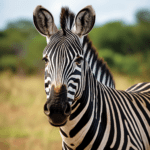
Introduction
Zebras are undoubtedly some of the most iconic and recognizable animals in the world, known for their distinctive black and white stripes. These equids, closely related to horses and donkeys, inhabit various regions of Africa and have captured the imagination of people worldwide. While their striking appearance is well-known, there are several odd and fascinating facts about zebras that often go unnoticed. In this article, we’ll explore ten such peculiar but true aspects of these captivating creatures.
- Black with White Stripes or White with Black Stripes? The age-old question of whether zebras are black with white stripes or white with black stripes has intrigued researchers for years. The answer lies in their embryonic development; zebras start with a dark skin color, and as their stripes develop, the melanin is inhibited in these regions, resulting in the iconic black and white pattern.
- Camouflaging Stripes: Defense Mechanism? While it might seem counterintuitive, the zebra’s bold black and white stripes are believed to function as a form of camouflage. When a group of zebras runs together, their stripes create an optical illusion that makes it challenging for predators, such as lions and hyenas, to pick out a single zebra from the group.
- Individual Zebra Patterns: Nature’s Unique Barcode Just like human fingerprints, each zebra has a unique pattern of stripes, making them easily distinguishable from one another. This distinctiveness is essential for social interactions within the herd and helps in identifying family members.
- Zebras are Actually Black Horses? Underneath their striped exterior, zebras share an astonishing resemblance to horses. Their skeletal structure, muscle arrangement, and even their braying sound are more similar to horses than one might expect.
- Zebra Crossing: Nature’s Pedestrian Crosswalk The term “zebra crossing” might remind you of pedestrian crossings on roads, but the inspiration for these crossings actually comes from zebras’ natural behavior. When these animals migrate across vast landscapes, they often form orderly lines, creating a natural version of a crosswalk.
- Zebras and Insects: Odd Relationship Zebras have a curious habit of rolling in dust and mud, which might seem counterproductive for cleanliness. However, this behavior serves as a defense against blood-sucking insects. The layer of dust or mud can act as a barrier, making it harder for parasites to latch onto their skin.
- Zebras’ Amazing Adaptation: Water Scarcity In the harsh African savannah, water can be scarce, and zebras have evolved to survive with minimal water intake. They can actually drink up to half their body weight in one go, rehydrating rapidly when they have access to water.
- A Zebra’s Unique Call: The Quagga’s Echo The now-extinct quagga, a subspecies of zebra, played a role in uncovering a unique aspect of zebras’ communication. When zebras make their characteristic “barking” sound, it’s believed to serve as a form of long-distance communication that can be heard over several kilometers.
- Stripes: Cooling System or Social Tool? The debate over the purpose of zebra stripes continues. While the camouflage and insect-repelling theories are well-known, another possibility is that the stripes help regulate the zebras’ body temperature. The alternating black and white patterns might create a cooling airflow along their bodies.
- Domestication Difficulties Unlike their horse and donkey relatives, zebras have proven challenging to domesticate. Their unpredictable and sometimes aggressive behavior, along with their strong fight-or-flight instincts, have made them less amenable to human control.
Conclusion
Zebras’ enigmatic black and white stripes might be their most famous feature, but these incredible animals are so much more than just their appearance. Their behavior, adaptations, and unique characteristics reveal a captivating world of odd but true facts that continue to amaze and intrigue researchers and wildlife enthusiasts alike. From their role in shaping human infrastructure to their intricate social dynamics, zebras are a testament to the remarkable diversity and complexity of the natural world.

